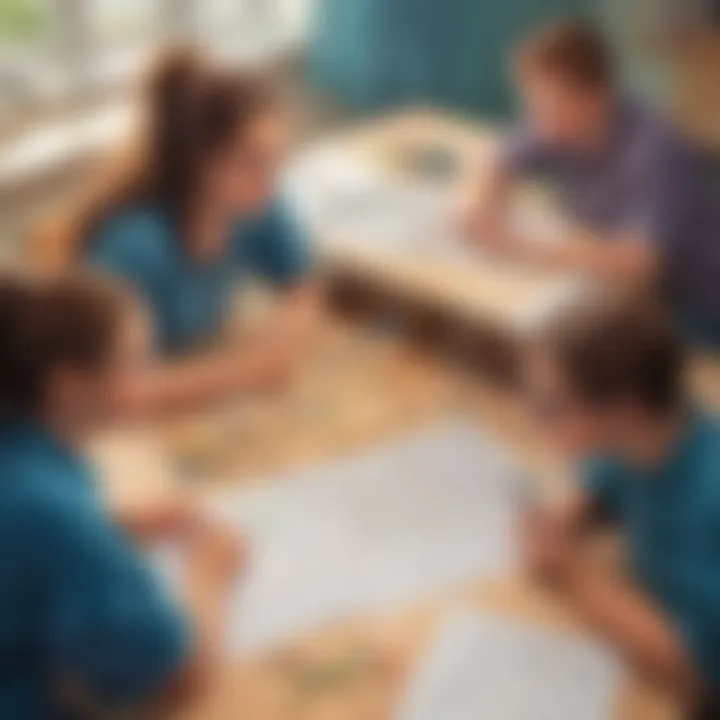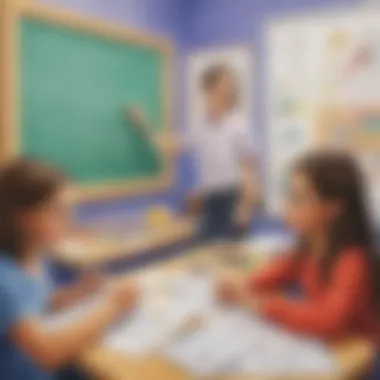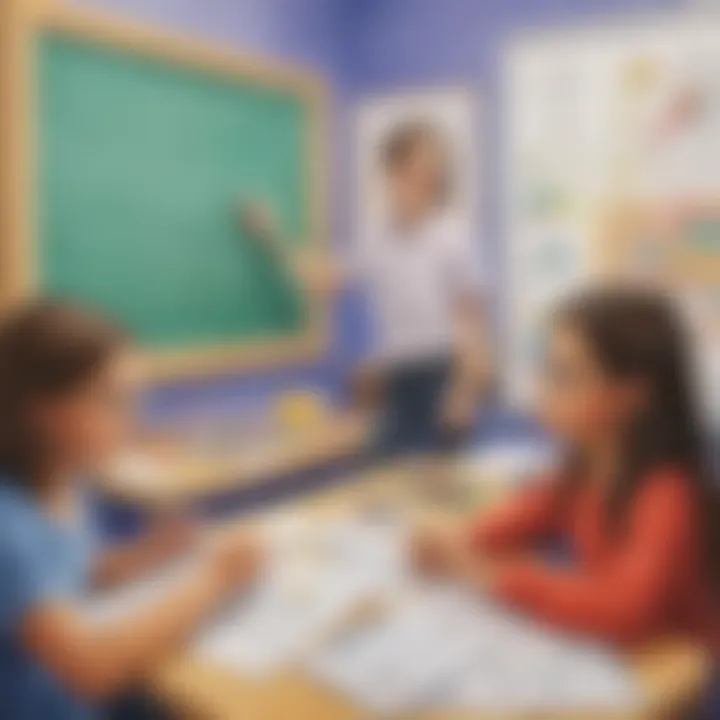Engaging Project-Based Learning Ideas for Mathematics


Intro
In the rapidly changing landscape of education, finding effective and engaging ways to teach mathematics can feel like searching for a needle in a haystack. Classrooms often become a battleground of disinterest, where textbook methods overshadow hands-on learning.p> However, project-based learning emerges as a beacon of hope. This approach enables students to dive into real-world problems, enhancing their critical thinking and creativity in solidifying mathematical concepts.p> In this guide, we will explore innovative ideas tailored to elementary school environments, focusing on activities that captivate young minds and foster a collaborative spirit.p>
Creative Activities
Craft Ideas
Project-based learning should stimulate young imaginations. Crafting provides a tactile dimension to teaching mathematics. For instance, creating geometric shapes using straws allows children to visualize and manipulate these forms. They can not only measure edges and angles but also discover the area and perimeter by interacting with materials.
Students can foster their creativity by designing their own math-related crafts, like building a mini city using cardboard boxes. Each box can represent a different mathematical concept, like fractions by proportionally scaling the sizes of buildings.
Step-by-Step Guides
An engaging craft idea could be making a math-themed board game. Here’s a simple guide:
- Gather materials: Poster board, markers, scissors, and dice.
- Design the board: Encourage students to create a path that includes various math problems at certain checkpoints.
- Create question cards: Make a set of cards with questions tailored to the math curriculum.
- Play and learn: Students can take turns solving problems as they move around the board.
As they play, children reinforce their learning in a light-hearted atmosphere. This interactive setup not only makes math fun but also promotes teamwork and critical thinking as they discuss strategies.
Educational Value
By engaging in these creative activities, students develop essential skills. Craft-based projects enhance their spatial awareness and improve fine motor skills. They also learn to collaborate and communicate, especially when working in groups. This hands-on experience solidifies mathematical concepts by transforming abstract ideas into tangible ones.
Fun Quizzes
Quiz Topics
Quizzes serve as a fun yet insightful tool for solidifying knowledge. Topics may range from basic arithmetic to introductory geometry. By tailoring quizzes to subjects that resonate with students, educators can spark interest and comprehension.
Question Types
The variety of question types can keep students on their toes. Here’s a look:
- Multiple Choice: Quick assessment of their understanding.
- Fill in the Blanks: Enhances recall and application skills.
- True or False: Encourages critical thinking about mathematical statements.
- Word Problems: Connects math to real life, urging students to apply learned concepts.
Knowledge Reinforcement
These quizzes not only serve as tests but reinforce learning. When children engage with different question formats, they develop problem-solving skills and a deeper understanding of mathematical principles. Furthermore, instant feedback allows them to recognize areas needing improvement, fostering growth through practice.
Fact-Based Articles
Topics
Delving into a range of math-related topics can spark curiosity in students. Articles can cover diverse subjects such as statistics in everyday life, the importance of geometry in architecture, or exploring patterns in nature. Each of these subjects can draw connections between math and the world around them.
Engaging Content
The language used in these articles should be inviting. Writing in a conversational tone encourages students to explore concepts without feeling overwhelmed. Using ample visuals and relatable examples is essential to help children grasp complex ideas more naturally.
Understanding Project-Based Learning
Project-Based Learning (PBL) is emerging as a powerful pedagogical approach in today's education landscape, especially within the realm of mathematics. This method actively engages students, providing a dynamic platform for them to interact with mathematical concepts through hands-on projects. The significance of understanding this approach lies not only in its ability to enhance computational skills but also in fostering a deeper comprehension of how math relates to the world around us.
Definition and Core Principles
At its core, Project-Based Learning can be defined as an instructional strategy where students gain knowledge and skills by working on an extended project that mimics real-life challenges. This process often leads to products or presentations that signify mastery over the subject matter. Some key principles that support effective Project-Based Learning include:
- Engagement: Students are more likely to absorb knowledge when they feel invested in their learning journey.
- Collaboration: PBL often involves teamwork, building essential interpersonal skills among students.
- Critical Thinking: Rather than rote memorization, this method emphasizes analytical and problem-solving skills.
Understanding these principles is vital for educators aiming to implement PBL successfully, as they form the backbone of this teaching strategy.
Importance in Mathematics Education
The importance of Project-Based Learning in mathematics education cannot be overstated. Traditional teaching methods often fall short of capturing students' imaginations. PBL, however, bridges that gap by:
- Encouraging Real-World Connections: Mathematics is, at its heart, a tool for solving real-world problems. PBL allows students to see this connection, making learning more relevant. For instance, a project that involves budgeting for a school event can teach students about percentages, addition, and subtraction in a practical context.
- Boosting Motivation: When students are engaged in projects that interest them, their motivation levels soar. This intrinsic motivation can lead to sustained interest in mathematics.
- Fostering Independence: Students learn to take ownership of their learning. They are empowered to explore, experiment, and apply mathematical principles, honing their decision-making skills along the way.
As educators embrace innovative approaches like Project-Based Learning, it becomes clear that the benefits extend beyond mere academic performance. The holistic impact on students' critical thinking, creativity, and problem-solving abilities makes Project-Based Learning a necessity in modern mathematics education.
"Mathematics is not about numbers, equations, or algorithms: it is about understanding."


In summary, delving into the principles and significance of Project-Based Learning allows educators and parents to harness its full potential, benefiting students in their academic journeys. Embracing this approach in mathematics could very well redefine how children engage with the subject.
Characteristics of Effective Mathematics Projects
In today’s educational landscape, mathematics is often seen as a rigid field of study divorced from the fluid dynamics of daily life. However, when educators design projects that embody certain characteristics, they can transform math into a vibrant, engaging subject. Characteristics of effective mathematics projects pave the way for deeper learning experiences and help students build connections with the material, making the subject more relatable and enjoyable.
Real-World Relevance
One of the fundamental traits of a successful math project is its connection to the real world. When students see how mathematical concepts are woven into the fabric of everyday life, they tend to become more invested in their work. For instance, using local grocery prices to teach students about budgeting or gathering data from community surveys for statistical analysis can show learners that math isn’t just about numbers on a page.
Real-world relevance encourages students to ask questions like, "How can I apply this skill in a real-life situation?" It transforms the often abstract nature of math into something they can see and touch. This kind of engagement often leads to powerful comprehension—students become problem solvers, able to harness mathematical principles to navigate life effectively.
"Connecting learning to real life makes knowledge stick."
Student-Centered Learning
Another vital characteristic is the focus on student-centered learning. This approach empowers students, allowing them to take charge of their educational journey. Instead of merely absorbing information through lectures, students are thrust into active roles where they investigate, hypothesize, and draw conclusions. For example, consider a project where students create their own scale models of a building. In doing so, they inherently need to grasp concepts of geometry, measurement, and spatial reasoning.
By engaging students actively, they develop critical thinking skills. It’s not just about getting the right answer; it’s about understanding and interpreting the process leading to the solution. Their learning becomes personal, fostering a deeper appreciation and understanding of mathematical principles. Moreover, this adaptability allows students to tackle challenges they often face collectively, which aids in building teamwork skills.
Interdisciplinary Connections
Lastly, effective mathematics projects often draw upon interdisciplinary connections. When math is combined with other subjects, it becomes a gateway rather than a barrier. For instance, integrating principles of art with geometry through tessellation encourages creativity alongside analytical thinking. As students explore how shapes fit together, they’re not merely calculating angles; they’re also expressing themselves artistically.
These connections enhance overall learning. It's about showing students that math doesn’t exist in a vacuum; it influences and intertwines with various fields such as science, art, and history. By incorporating elements from these diverse disciplines, lessons become richer and more insightful. Students can see the practicality of math in various contexts, reinforcing its importance in a variety of real-life applications.
By ensuring projects are relevant, centered around students, and linked with other subjects, educators can spark a passion for mathematics that lasts well beyond the classroom. This holistic approach can truly inspire the next generation of thinkers, helping them see the beauty of math in both abstract concepts and tangible realities.
Creative Project Ideas for Mathematics
Engaging students in mathematics through project-based learning not only nurtures their mathematical skills but also promotes critical thinking and collaboration. Creative projects breathe life into abstract mathematical concepts, making them tangible and relevant to students’ everyday experiences. These project ideas often encourage active learning, where students, instead of being passive listeners, become explorers and creators. When students get their hands dirty by organizing a school store, planning a community garden, or designing a board game, they transform math from a subject encountered in isolation into an adventure filled with possibilities.
Designing a School Store
Designing a school store is a project that combines various mathematical elements like pricing, budgeting, and even marketing. Students will benefit from this project in many ways, ensuring that every kid finds something meaningful in maths. It takes the mundane aspects of mathematics and turns them into real-world applications, transforming them from numbers on a page into figures that tell a story of profit or loss.
Setting Pricing Strategies
Setting pricing strategies is essential in creating a sustainable school store. Students learn to analyze costs, value perception, and competition when deciding how much to charge for items. This aspect encourages critical thinking as they must consider not just their costs but also how much their peers are willing to pay. The unique feature of this exercise is that it requires students to utilize decision-making skills and apply mathematical concepts such as fractions or percentages while contemplating scarcity and demand. This hands-on experience makes pricing strategies a popular choice among educators looking for engaging ways to teach mathematics. While it can lead to debates about fairness or market value, the conversations sparked by these discussions enhance their understanding of economics.
Calculating Profits and Losses
Calculating profits and losses teaches students the financial side of running a store. They will learn to subtract costs from revenue to find profit margins or how to handle losses if items don’t sell as expected. Emphasizing this calculation provides students with a strong grasp of basic financial literacy, which is crucial for their future. The core characteristic here is the application of arithmetic in real-world scenarios, making it not just a theoretical exercise but a practical one. While the project is beneficial, it also exposes students to the reality that not every venture will be profitable, helping them appreciate the importance of risk-taking and planning in business decisions.
Marketing and Promotion Analysis
Marketing and promotion analysis brings a new dimension to the school store project. Students analyze different marketing strategies to attract customers, such as posters, social media initiatives or even school announcements. This part of the project enables students to delve into data interpretation, helping them understand what types of promotions lead to sales boosts. By observing which marketing efforts were successful, students boost their analytical abilities. It’s an engaging way to teach the importance of research and reaching out effectively. However, it can have challenges, as students must navigate what types of promotions might be perceived as overly aggressive or inauthentic, driving essential discussions about ethics in advertising.
Building a Community Garden
A community garden serves as a fruitful project for mathematics, where students apply measuring, scheduling, and budgeting to create something beautiful and beneficial. This project emphasizes relationships with the environment, making math feel even more relevant and useful.
Measuring Area and Perimeter
Measuring area and perimeter is a hands-on activity where students will determine how much land a garden occupies and how much fencing is required. This practical application reinforces their understanding of geometric concepts and offers insight into how measurement impacts gardening success. Students learn to calculate area by multiplying length and width and grasp the concept of perimeter by adding all sides of the garden plot. It highlights the critical feature of spatial awareness in mathematics. Although straightforward, challenges may arise when dealing with irregular shapes or figuring out plots, pushing students to think creatively about their solutions.
Planting Schedule and Growth Tracking
Creating a planting schedule and tracking growth fosters responsibility and project management skills. Students plan when to plant seeds, water them, and note their growth, applying their mathematical skills to create schedules utilizing calendars and spreadsheets. The beauty of this project lies in its relationship to the seasons - giving students a direct observation of time and growth management. It’s insightful and could even include stringing together a history of plant growth data, making it a popular choice. The risk here is often about patience; some students might find it tedious, yet understanding the seasonality of plants creates an engaging conversation about sustainability and care.
Budgeting for Supplies
Budgeting for supplies teaches students financial literacy through planning and resource allocation. They will price seeds, soil, tools, and any other needs, prompting important discussions about cost versus benefit. The unique feature of budgeting is that it incorporates thought-out decision-making skills, crucial for running any successful community project. While beneficial, this can lead to struggles when students realize they can’t afford everything they want, pushing them to prioritize and negotiate. This helps transform an abstract concept into something very relevant and applicable.
Creating a Math Board Game
Creating a math board game allows artistic expression while honing mathematical skills. It’s an engaging way for students to synthesize what they’ve learned and present it in a fun format.
Game Mechanics Based on Mathematical Concepts
Incorporating game mechanics based on mathematical concepts invites students to think critically about how math can be represented in playful formats. They can use strategies to encourage learning through gameplay. Students brainstorm ways to include elements like rolling dice for probability or math questions as checkpoints. The outcome is that students not only apply their math knowledge but also learn to think about foundational concepts creatively. A possible downside is that some might focus too much on fun and shy away from the math elements. This balance is essential in maintaining the educational integrity of their game.
Designing Game Components


Designing game components such as boards, cards, and pieces is where creativity shines. Students need to consider usability and aesthetics when crafting engaging game components. This aspect fosters teamwork as they collaborate. The unique feature is the challenge of ensuring that every element serves a purpose within the math framework of the game. On the downside, some students may find it hard to visualize their concepts on paper, causing frustration which could impact group morale but ultimately can lead to personal growth. They develop a sense of ownership over their creation.
Testing and Iterating the Game
Testing and iterating the game is a critical part of the design process. Students can gather feedback from peers and make adjustments, honing their critical thinking further. This step introduces concepts such as user testing and improvement cycles. The most engaging feature is that this iterative process simulates real-world development practices used in game design. However, it may require time and perseverance, as students must deal with setbacks. This challenge is beneficial as it instills resilience and the understanding that not all ideas are perfect on the first try.
Project-based learning like these mathematical explorations is a compass directing students to foster lifelong skills as they navigate their educational journey.
Implementation Strategies
Implementing project-based learning in mathematics is not just a whimsical endeavor; it’s a strategic maneuver aimed at transforming how students interact with math. The integration of projects into the curriculum fosters a deeper understanding of mathematical concepts while keeping students engaged. This approach emphasizes relevance and practicality—two essential ingredients for successful learning. When done effectively, it doesn’t merely teach math; it applies it, turning mundane numbers into tools that solve real-world problems.
Integrating Projects into the Curriculum
Integrating projects into the established curriculum requires a bit of foresight and creativity. Teachers should look for hooks to link mathematical content with students’ interests and daily life. For example, instead of simply explaining percentages theoretically, a project could involve students analyzing discount strategies for products in a local store. This not only reinforces their understanding but also engages their curiosity.
Furthermore, setting predefined learning objectives ensures that while students are absorbed in their projects, they continue to move toward the curriculum goals. Adapting lessons to include project work might also require teachers to get a tad flexible, adjusting timelines and combining subjects to create a hybrid learning experience.
Collaborative Learning Techniques
Collaboration is at the heart of project-based learning. Kids tend to thrive in teamwork settings where they can bounce ideas off one another. Encouraging students to work in diverse groups allows them to explore varied perspectives while solving mathematical problems. Think of a project where students develop a budget for a hypothetical field trip; they can engage in discussions about costs, savings, and planning—a real math meet-up in action. Facilitation from educators is vital here; guiding the discussions and ensuring every student contributes is key.
- Benefits of Collaborative Learning:
- Builds communication skills
- Encourages shared problem-solving
- Promotes accountability within groups
Educators will notice that when students collaborate, their enthusiasm for learning mathematics amplifies. It’s like hitting the nail on the head; the group dynamic breeds motivation.
Utilizing Technology in Math Projects
Interactive Software Tools
Interactive software tools play a monumental role in enriching students' project experiences. Their allure lies in their ability to turn abstract math concepts into engaging, visual explorations. Programs like GeoGebra allow students to manipulate geometric shapes, helping them grasp area, volume, and other complex ideas intuitively.
Applications designed for graphical representation not only enhance understanding but also cater to different learning styles. For instance, a student who struggles with equations may find manipulating a graphical model more straightforward.
- Key Characteristics of Interactive Software Tools:
- Visual aids for concept demonstration
- Hands-on experiences fostering deeper learning
- Easily adaptable to individual learning paces
However, there are caveats. Reliable access to technology and adequate training for both teachers and students is necessary to harness its full potential. Otherwise, the tools may become a distraction rather than an aid.
Online Collaboration Platforms
Online collaboration platforms serve as a bridge, helping students collaborate beyond the physical classroom walls. Tools like Google Classroom or Padlet allow for project sharing and discussions, fostering a sense of community among learners.
Utilizing these platforms can enhance students' presentation skills as they learn to present their findings digitally and critique others' projects constructively. They also encourage responsible digital communication, essential in today’s tech-savvy world.
- Essential Features of Online Collaboration Platforms:
- Seamless sharing and feedback
- Remote teamwork for flexibility
- Organized project management tools
While there are significant advantages, challenges arise in managing online interactions, ensuring students engage appropriately without diverging from the project goals.
Overall, the implementation strategies surrounding project-based learning encourage a hands-on, immersive approach to teaching mathematics. By integrating projects effectively, promoting collaboration, and leveraging technology, educators can reshape the landscape of mathematics education.
Assessment in Project-Based Learning
Assessment holds a pivotal role in project-based learning, especially within the context of mathematics. When students embark on projects, they are not only engaging with mathematical concepts, but they also navigate through real-world problem-solving. This hands-on approach demands a distinct assessment strategy that prioritizes ongoing feedback and reflective evaluation.
Evaluating student understanding through formative and summative assessments allows educators to capture a comprehensive picture of learning in action. Just as baking a cake requires proper measurements and adjustments, assessment in project-based learning each time checks the depth of understanding, fostering growth and improvement along the way.
The assessment not only measures the end result but also emphasizes the process through which students arrive at their conclusions. Without effective assessment, it’s like sailing without a compass—students might float along, but they won’t know if they’re on the right course.
Formative Assessment Techniques
Formative assessments are akin to the feedback you receive during a workshop. They don't just tell you if you're right or wrong; they provide the necessary insights to create improvement. Frequent and informal check-ins during a project can act like a safety net for both teachers and students. These assessments serve to refine students’ understanding and keep motivation high throughout the learning process.
Some techniques to employ include:
- Observational Notes: Keeping track of student engagement and participation during group work helps educators adjust instruction on the fly.
- Peer Reviews: Encouraging students to assess each other's work teaches them to engage critically and constructively with their peers' efforts.
- Quick Check-In Questions: Using exit tickets or digital polls at the end of a lesson can summarize student understanding and highlight areas needing further exploration.
The overarching goal of formative assessment in this approach is to create an ongoing conversation about learning. This not only positions students as active participants, helping them stay invested, but also allows teachers to adapt instruction in real-time to meet diverse learning needs.
Evaluating Student Projects
When it comes to assessing completed projects, a holistic approach is crucial. Evaluating student projects does more than assign a grade; it fosters an understanding of the learning journey and encourages students to reflect on their work critically.


Rubrics and Criteria
Rubrics serve as a guiding map in the assessment landscape. They clarify what constitutes success in a project, breaking down expectations into clear indicators. This makes the assessment process transparent, allowing students to understand exactly what to strive for and helping teachers remain consistent and fair in their evaluations.
A key characteristic of effective rubrics is their ability to provide specific feedback on various aspects of the project, such as:
- Content Accuracy: Ensuring that mathematical principles are applied correctly.
- Creativity and Innovation: Valuing original thinking in problem-solving approaches.
- Presentation Skills: Assessing how well students communicate their findings.
Their unique feature lies in fostering autonomy; students can self-assess based on the rubric, which encourages ownership of their learning. While rubrics can sometimes feel rigid, they actually empower students to gauge their performance independently, pinpoint areas for improvement, and channel their creativity into future projects.
Student Reflections and Self-Assessment
As students engage in projects, encouraging them to reflect on their experiences can be particularly illuminating. Student reflections and self-assessment prompt learners to think critically about their process and outcomes. This practice allows students to develop metacognitive skills, helping them recognize their strengths and identify where they might wish to refocus their efforts.
Key characteristics of this practice are:
- Personal Insights: Students gain a deeper understanding of their learning through self-examination, which cultivates a sense of responsibility.
- Set Goals for Improvement: Reflective practices encourage students to think about how to apply what they learned in future projects.
The distinctive advantage of self-assessment lies in its ability to nurture self-awareness. However, it requires guidance from educators to ensure students remain realistic and constructive in their assessments. With proper scaffolding, this approach can transform students into self-directed learners, ready to tackle future challenges with confidence.
"Assessment in project-based learning is not just the icing on the cake; it's the whole recipe!"
Challenges and Solutions in Project-Based Learning
Incorporating project-based learning into the mathematics curriculum offers numerous advantages, yet it also presents various challenges that educators must navigate. Understanding these hurdles, along with effective solutions, is important for enhancing the teaching and learning process. A thorough grasp of these challenges allows teachers to preemptively address potential areas that may hinder student participation and engagement. This not only benefits the students but also helps educators to create a more seamless educational experience.
Addressing Diverse Learning Needs
Every classroom is a tapestry of unique learners, each bringing their own strengths and struggles. This diversity can make project-based learning feel like a tightrope walk for teachers. On one side of the rope, there’s the need to challenge advanced students, while on the other, there’s the necessity to provide support for those who may need more guidance. To tackle this iconically tricky balancing act, educators must adopt a differentiated instruction approach.
Practical strategies include:
- Grouping students by various abilities, ensuring collaborative learning while providing enough challenge for everyone.
- Offering tasks with varying degrees of complexity, so that all can partake based on their comprehension skills.
- Utilizing technology tools that allow for personalized learning, such as adaptive math programs that can fine-tune practice based on the student’s proficiency.
By fostering an inclusive environment, teachers can ensure that no student feels left behind and everyone feels they are an integral part of the project.
Time Management Strategies
Time is as precious in the classroom as gold is in a treasure chest. When it comes to project-based learning, managing time effectively is essential to achieve the rich learning outcomes educators aim for. Without a solid plan, projects can spiral out of control, leading to rushed conclusions that don’t truly reflect students' understanding of mathematical concepts.
To maintain control, here are a few strategies:
- Set clear timelines: Provide students with a comprehensive outline that includes milestones to help keep the project on track. This way, students know what is expected and by when.
- Break projects into manageable tasks: Ensuring the workload is divided into smaller, achievable parts can ease the pressure and allow students to focus on one aspect at a time.
- Reflective checkpoints: Including regular intervals for assessment allows students to pause, reflect, and adjust their course. This practice not only enhances learning but also encourages a habit of self-monitoring.
Implementing these strategies can create a smoother workflow and uphold the integrity of students’ learning journeys.
Balancing Curriculum Standards
The tension between innovative teaching methods and rigid curricular requirements often leaves educators feeling like they’re out on a limb. While the curriculum lays down the foundation, project-based learning demands flexibility and creativity. Balancing these two elements is crucial for effective education.
To keep both hands on the wheel, consider the following:
- Embed standards into projects: Align project objectives closely with established standards, ensuring students learn essential concepts while engaging in creative inquiry. For example, while designing a game to learn about probability, the project simultaneously meets geometry standards.
- Collaborate with colleagues: Building partnerships with other teachers can provide insights that support curriculum integration, allowing for interdisciplinary projects that encompass multiple subjects.
- Continuous feedback: Regular input from both students and peers can illuminate areas where a project may align or stray from curriculum goals, thereby facilitating necessary adjustments.
By striking a balance between the necessity of meeting standards and the innovative essence of project-based learning, educators can cultivate a richer, more meaningful educational experience for their students.
In summary, while project-based learning in mathematics comes with its share of challenges, these hurdles can often become opportunities for growth. By addressing diverse learning needs, managing time wisely, and balancing curriculum standards, teachers can enhance both engagement and educational outcomes, creating a classroom environment where every student thrives.
The Future of Project-Based Learning in Mathematics
Project-based learning is swiftly becoming a cornerstone in mathematics education, especially for younger students. As schools continue to shift towards methods that engage learners in a profound way, understanding its future implications is crucial. It is not just about teaching children arithmetic; it's about fostering a mindset that values exploration, creativity, and real-life problem solving.
Emerging Trends
Global Collaboration Projects
One significant aspect of the future of project-based learning in mathematics is the rise of global collaboration projects. These initiatives allow students from different parts of the world to connect virtually and tackle mathematical challenges together. This connection boasts numerous benefits.
A key characteristic of global collaboration projects is their capacity to expose students to diverse perspectives. Students in an urban school might team up with peers in a rural area, sharing unique approaches to a common problem. This blending of ideas not only enriches the learning experience but also enhances understanding and cooperation among cultures. This is particularly beneficial because it engages students by making math relevant in a global context.
However, these projects do come with their own set of challenges. Time zone differences can complicate scheduling, and varying levels of technology access may cause disparities in participation rates. Still, the potential for interpersonal development and a richer understanding of global issues positions these projects as a valuable addition to mathematics education.
Project-Based Learning and STEM Education
Another integral trend is the intertwining of project-based learning with STEM education. This unique blend emphasizes the importance of not only mathematical skills but also science and technology, creating an interdisciplinary approach. Such a combination prepares students for future careers that require a solid understanding of various subjects working in unison.
A distinctive feature of this integration is its ability to highlight real-world applications of mathematics. When students engage in projects that involve building bridges or programming robots, they see firsthand how math serves as the backbone of these disciplines. This applies not only to theoretical concepts but also to practical approaches that students can utilize in various contexts.
Even with these advantages, educators need to be aware of the potential pitfalls. Balancing mathematical rigor with creativity can sometimes lead to students losing sight of fundamental mathematical principles amidst the excitement of project work. However, careful planning and structured guidelines can ensure that students gain a comprehensive understanding of mathematics alongside their applied learning.







